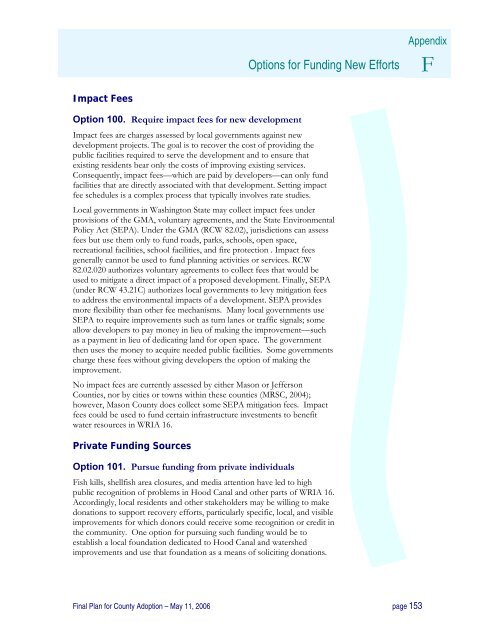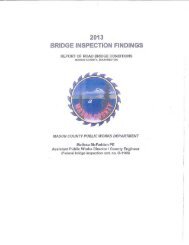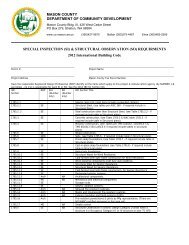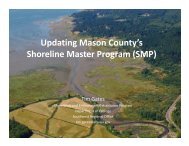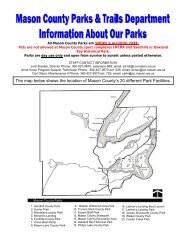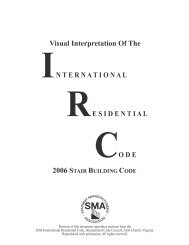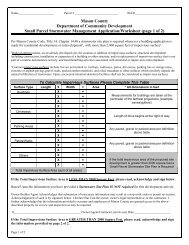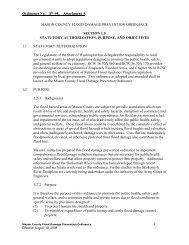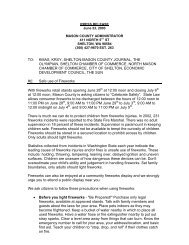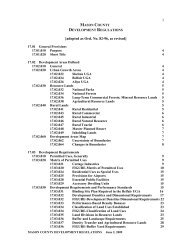Watershed Management Plan - Mason County
Watershed Management Plan - Mason County
Watershed Management Plan - Mason County
You also want an ePaper? Increase the reach of your titles
YUMPU automatically turns print PDFs into web optimized ePapers that Google loves.
Options for Funding New Efforts<br />
Appendix<br />
F<br />
Impact Fees<br />
Option 100. Require impact fees for new development<br />
Impact fees are charges assessed by local governments against new<br />
development projects. The goal is to recover the cost of providing the<br />
public facilities required to serve the development and to ensure that<br />
existing residents bear only the costs of improving existing services.<br />
Consequently, impact fees—which are paid by developers—can only fund<br />
facilities that are directly associated with that development. Setting impact<br />
fee schedules is a complex process that typically involves rate studies.<br />
Local governments in Washington State may collect impact fees under<br />
provisions of the GMA, voluntary agreements, and the State Environmental<br />
Policy Act (SEPA). Under the GMA (RCW 82.02), jurisdictions can assess<br />
fees but use them only to fund roads, parks, schools, open space,<br />
recreational facilities, school facilities, and fire protection . Impact fees<br />
generally cannot be used to fund planning activities or services. RCW<br />
82.02.020 authorizes voluntary agreements to collect fees that would be<br />
used to mitigate a direct impact of a proposed development. Finally, SEPA<br />
(under RCW 43.21C) authorizes local governments to levy mitigation fees<br />
to address the environmental impacts of a development. SEPA provides<br />
more flexibility than other fee mechanisms. Many local governments use<br />
SEPA to require improvements such as turn lanes or traffic signals; some<br />
allow developers to pay money in lieu of making the improvement—such<br />
as a payment in lieu of dedicating land for open space. The government<br />
then uses the money to acquire needed public facilities. Some governments<br />
charge these fees without giving developers the option of making the<br />
improvement.<br />
No impact fees are currently assessed by either <strong>Mason</strong> or Jefferson<br />
Counties, nor by cities or towns within these counties (MRSC, 2004);<br />
however, <strong>Mason</strong> <strong>County</strong> does collect some SEPA mitigation fees. Impact<br />
fees could be used to fund certain infrastructure investments to benefit<br />
water resources in WRIA 16.<br />
Private Funding Sources<br />
Option 101. Pursue funding from private individuals<br />
Fish kills, shellfish area closures, and media attention have led to high<br />
public recognition of problems in Hood Canal and other parts of WRIA 16.<br />
Accordingly, local residents and other stakeholders may be willing to make<br />
donations to support recovery efforts, particularly specific, local, and visible<br />
improvements for which donors could receive some recognition or credit in<br />
the community. One option for pursuing such funding would be to<br />
establish a local foundation dedicated to Hood Canal and watershed<br />
improvements and use that foundation as a means of soliciting donations.<br />
Final <strong>Plan</strong> for <strong>County</strong> Adoption – May 11, 2006 page 153


